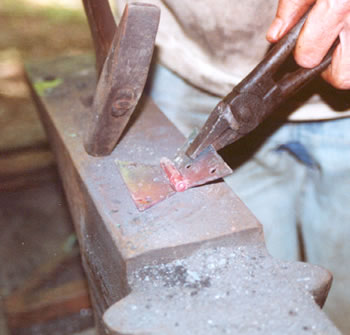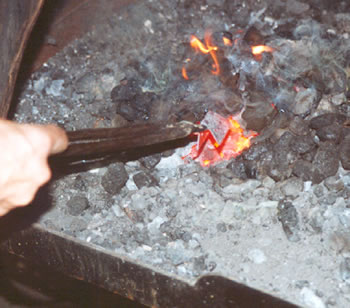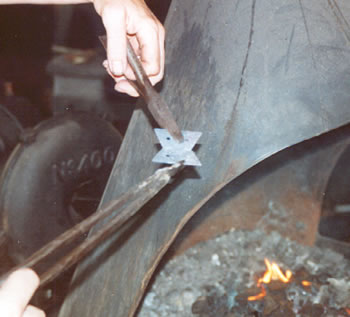
Beginning the forging
We forged the assembled hinges to put a chamfer on all the edges and to make the hinge lie flat.
Forging the Chamfers
The chamfers are forged using a small hammer. Since the stock cools so quickly it takes two heats to do this.

Heating the Hinge
The hinge is pulled quickly out of the fire, transferred from the special tongs to a pair of pliers and the second heat is taken to forge the chamfers.

Working the Joint
While the hinge is still hot, the joint is worked back and forth. The hinge will then be taken to a steel block to be flattened.

Wire Wheeling the Hinge
The hinge blank, after cooling, is tested to make sure it operates correctly, and that it lies flat. Then, it is placed under a treadle wire wheel to remove loose scale.
Usually it takes several heats to get the hinge properly flat and with a good layer of scale to hold the finish.

Making a Latch
is a description, with photos, of the steps we go through to make a Suffolk Latch.
Making a Hinge
is a description, like Making a Latch, that shows the steps we go through to make a Butterfly Hinge.
Making a Grip
shows the process for making a Cabinet Grip.
Blacksmith's Blog Posts
collects posts we created for the Horton Brasses blog in 2010 and 2011. There's information about the shop, what we make and how we make it, including links to two videos.
Tools of the Trade
shows some of the tools in Molly’s blacksmith shop.
Making a Living
describes how we became blacksmiths.
Glossary of Blacksmithing Terms
is linked to various words that are not commonly known by non-smiths throughout this section of the site.